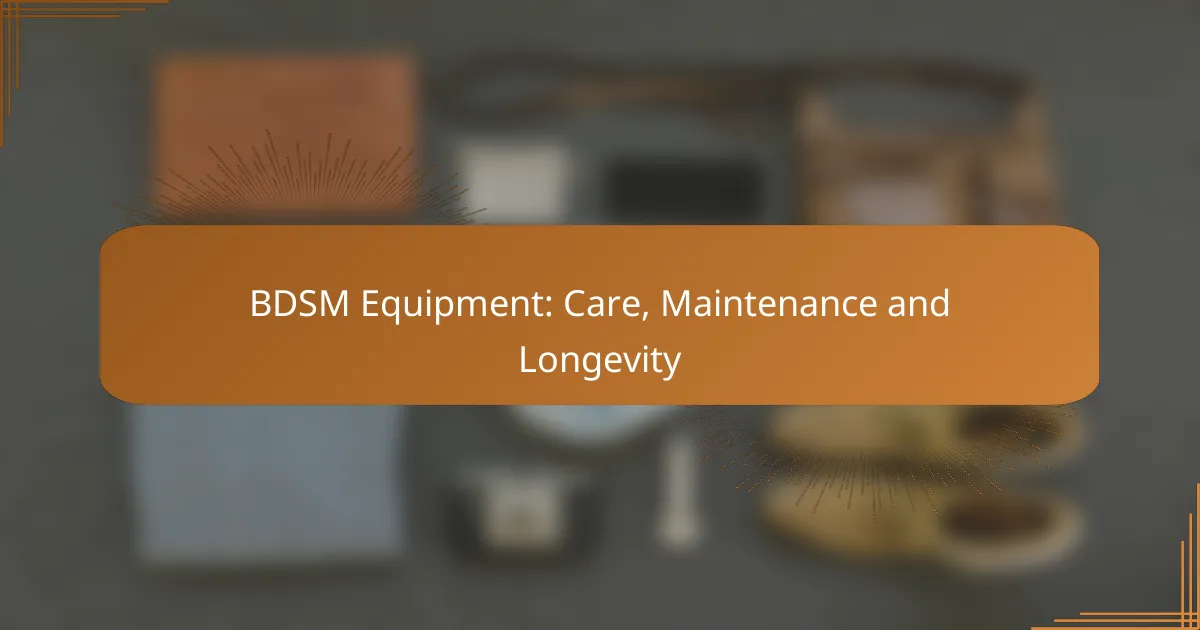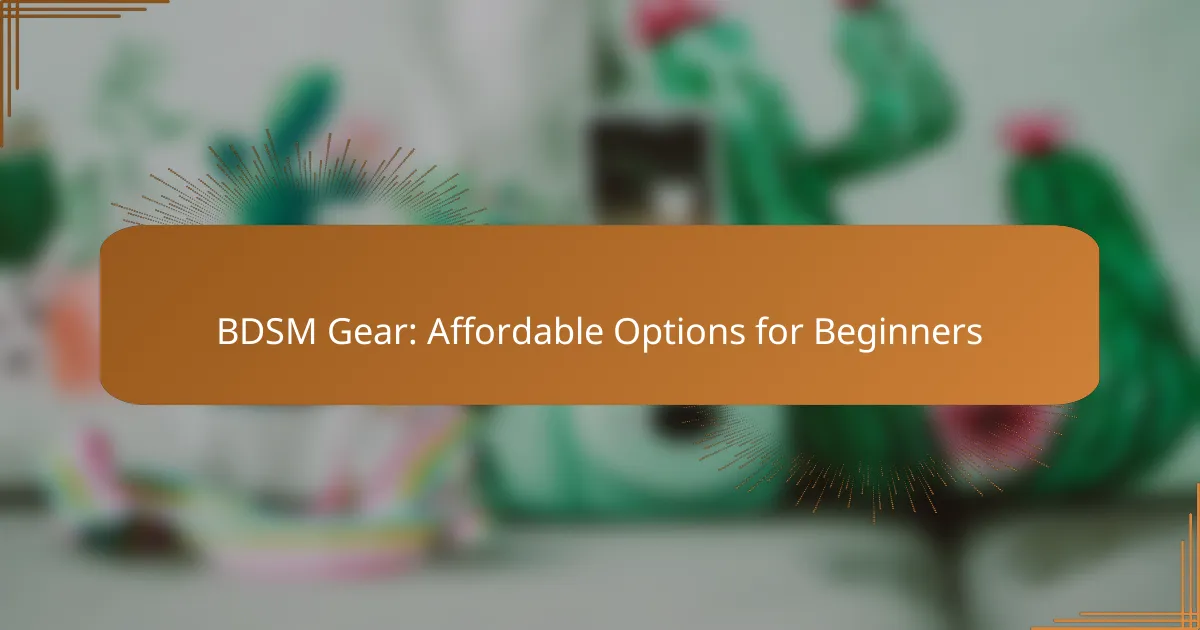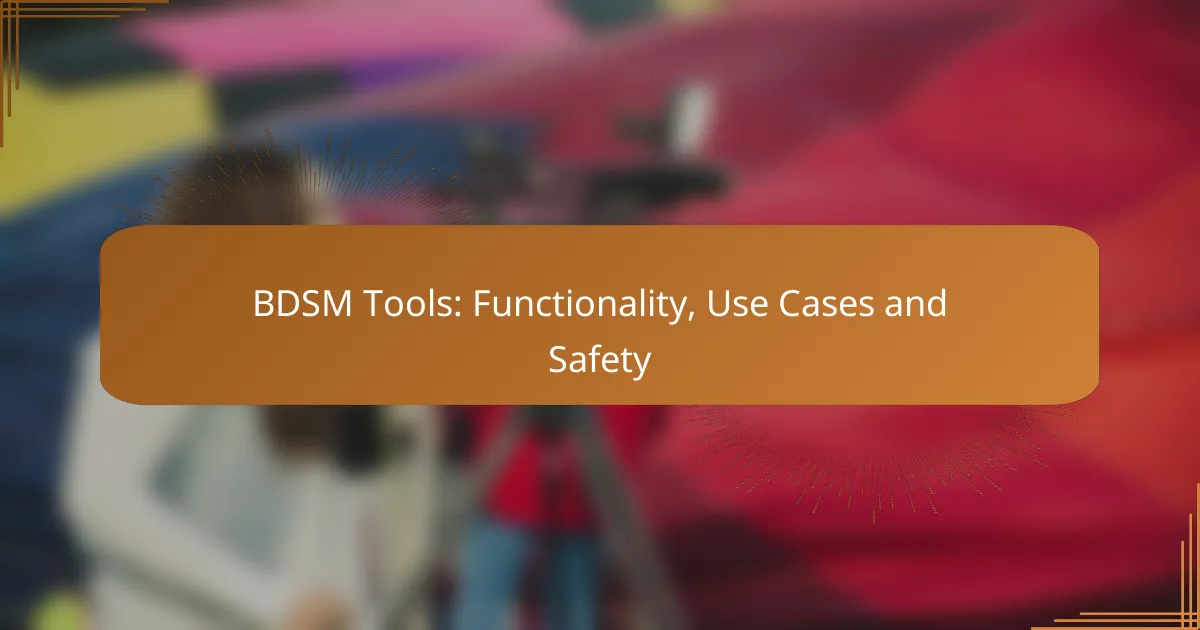Caring for [censured] equipment is essential for ensuring both safety and longevity. Regular cleaning, proper storage, and routine inspections tailored to the specific materials can significantly enhance the lifespan of your gear. By prioritizing quality and mindful handling, you can maintain optimal performance and enjoy a safe experience.
![How to care for [censured] equipment?](/wp-content/uploads/how-to-care-for-[censured]-equipment-1.webp)
How to care for [censured] equipment?
Caring for [censured] equipment involves regular cleaning, proper storage, and routine inspections to ensure longevity and safety. By following specific maintenance practices tailored to different materials, you can enhance the lifespan of your gear and ensure a safe experience.
Regular cleaning methods
Regular cleaning is essential to maintain the integrity of [censured] equipment. Most items can be cleaned with warm water and mild soap, while others may require specialized cleaners depending on the material. Always rinse thoroughly to remove any soap residue.
For items that come into direct contact with skin, such as cuffs or harnesses, consider cleaning them after each use to prevent bacteria buildup. A quick wipe-down with a disinfectant wipe can also be effective for non-porous materials.
Storage recommendations
Proper storage of [censured] equipment helps prevent damage and prolongs its usability. Store items in a cool, dry place away from direct sunlight to avoid degradation of materials. Use fabric pouches or dedicated storage boxes to keep them organized and protected.
Avoid stacking heavy items on top of each other, as this can lead to deformation or wear. For leather gear, consider using a breathable cover to prevent dust accumulation while allowing air circulation.
Material-specific care tips
Different materials require unique care approaches. For example, leather should be conditioned regularly with a suitable leather conditioner to prevent cracking. Silicone items can be cleaned with soap and water but should be stored away from other materials to avoid chemical reactions.
Metal equipment can be polished occasionally to maintain shine and prevent rust. Always check manufacturer guidelines for specific care instructions related to each material type.
Inspection for wear and tear
Regular inspections are crucial for identifying wear and tear on [censured] equipment. Check for fraying, cracking, or rusting, especially on items that experience significant stress during use. Look for any signs of deterioration that could compromise safety.
Establish a routine inspection schedule, ideally before and after each use, to ensure all equipment remains in good condition. Replace any damaged items immediately to avoid accidents.
Disinfection practices
Disinfection is vital for preventing infections when using [censured] equipment. Use appropriate disinfectants that are safe for the specific materials of your gear. For non-porous items, a solution of isopropyl alcohol or a commercial disinfectant can be effective.
For porous materials, such as fabric or leather, consider using a spray disinfectant that is safe for those surfaces. Always follow the manufacturer’s instructions for disinfection to avoid damaging the equipment.
![What are the best maintenance practices for [censured] gear?](/wp-content/uploads/what-are-the-best-maintenance-practices-for-[censured]-gear-2.webp)
What are the best maintenance practices for [censured] gear?
Proper maintenance practices for [censured] gear enhance its longevity and ensure safety during use. Regular cleaning, inspection, and proper storage are essential to keep the equipment in optimal condition.
Routine maintenance schedule
Establishing a routine maintenance schedule is crucial for the longevity of [censured] gear. Aim to clean and inspect your equipment after each use, checking for any signs of wear or damage. Additionally, perform a more thorough inspection monthly to address any issues that may arise over time.
For items made of leather or fabric, consider conditioning them every few months to maintain flexibility and prevent cracking. Metal and plastic items should be checked for rust or degradation, especially if exposed to moisture.
Repair techniques for common issues
Common issues with [censured] gear can often be repaired with simple techniques. For leather items, use leather glue to fix small tears and apply a leather conditioner to restore suppleness. For fabric gear, sewing up small rips can extend the life of the item significantly.
For metal equipment, such as cuffs or chains, inspect for rust and clean with a rust remover if necessary. If a component is broken, consider replacing it rather than attempting a temporary fix, as safety is paramount.
Upgrading equipment for longevity
Upgrading your [censured] gear can significantly enhance its durability and performance. Consider investing in high-quality materials, such as stainless steel or premium leather, which tend to last longer than cheaper alternatives. These materials often withstand wear and tear better, providing a safer experience.
Additionally, look for equipment with replaceable parts, such as adjustable straps or detachable components. This allows for easy repairs and upgrades without needing to replace the entire item, ultimately saving money in the long run.
![How to extend the lifespan of [censured] equipment?](/wp-content/uploads/how-to-etend-the-lifespan-of-[censured]-equipment-3.webp)
How to extend the lifespan of [censured] equipment?
To extend the lifespan of [censured] equipment, prioritize quality materials, proper usage, and suitable storage conditions. Regular maintenance and mindful handling can significantly enhance durability and performance.
Choosing durable materials
Selecting high-quality materials is crucial for the longevity of [censured] equipment. Look for items made from robust materials such as stainless steel, silicone, or leather, which can withstand wear and tear over time.
Consider the intended use when choosing materials. For instance, stainless steel is ideal for impact play due to its strength, while silicone is preferable for safe and comfortable body contact. Avoid cheaper plastics that may degrade quickly.
Proper usage techniques
Using [censured] equipment correctly is essential for maintaining its condition. Always follow manufacturer guidelines and avoid excessive force that could damage the equipment.
Incorporate safe practices, such as checking for wear before each use and cleaning items after sessions. For example, leather should be conditioned regularly to prevent cracking, while metal can be polished to maintain its shine and integrity.
Environmental factors affecting longevity
Environmental conditions can significantly impact the lifespan of [censured] equipment. Store items in a cool, dry place away from direct sunlight to prevent material degradation.
Humidity can lead to mold growth on fabrics and leather, while extreme temperatures can warp or weaken certain materials. Consider using protective cases or bags to shield equipment from environmental stressors.
![What are the common mistakes in [censured] equipment care?](/wp-content/uploads/what-are-the-common-mistakes-in-[censured]-equipment-care-4.webp)
What are the common mistakes in [censured] equipment care?
Common mistakes in [censured] equipment care include using inappropriate cleaning agents, neglecting regular maintenance, and improper storage practices. These errors can lead to equipment degradation, safety hazards, and a shorter lifespan for your gear.
Improper cleaning agents
Using the wrong cleaning agents can damage [censured] equipment. For instance, harsh chemicals or abrasive cleaners can degrade materials like leather, silicone, or metal. Always opt for mild, pH-balanced cleaners specifically designed for the material of your equipment.
Additionally, avoid using alcohol-based products on sensitive materials, as they can cause drying and cracking. Instead, consider using warm water and gentle soap, or specialized cleaning solutions recommended by manufacturers.
Neglecting regular maintenance
Regular maintenance is crucial for ensuring the longevity of [censured] equipment. This includes inspecting items for wear and tear, tightening screws, and replacing any worn-out parts. Schedule maintenance checks every few months, or more frequently if the equipment is used often.
For example, leather items should be conditioned periodically to prevent drying and cracking, while metal components may need lubrication to prevent rust. Keeping a maintenance log can help track when each item was last serviced.
Incorrect storage practices
Improper storage can lead to damage and deterioration of [censured] gear. Avoid storing equipment in damp or humid areas, as moisture can promote mold and mildew growth. Instead, keep items in a cool, dry place, ideally in breathable bags or containers.
Additionally, avoid stacking heavy items on top of one another, which can cause deformation. Use hooks or racks for hanging items like restraints and whips, and ensure that everything is organized to prevent tangling or unnecessary wear.
![What are the prerequisites for safe [censured] practices?](/wp-content/uploads/what-are-the-prerequisites-for-safe-[censured]-practices-5.webp)
What are the prerequisites for safe [censured] practices?
Safe [censured] practices require informed consent, clear communication, and a thorough understanding of the equipment involved. Participants should establish boundaries and safe words to ensure a respectful and enjoyable experience.
Understanding equipment types
Different types of [censured] equipment serve various purposes, including restraints, impact toys, and sensory tools. Common items include handcuffs, floggers, blindfolds, and paddles, each designed to enhance specific sensations or experiences.
When selecting equipment, consider factors like material, safety features, and ease of use. For instance, leather and silicone are popular for their durability and comfort, while metal can be more rigid and intense. Always prioritize quality to ensure safety during use.
Safety protocols for usage
Implementing safety protocols is crucial for minimizing risks during [censured] activities. Always conduct a risk assessment before using any equipment, discussing potential hazards with your partner. Establish clear safe words that can be easily remembered and understood.
Regularly inspect equipment for wear and tear, ensuring everything is in good condition before use. Avoid using items that show signs of damage, as they can lead to accidents. After each session, clean and store equipment properly to maintain its longevity and hygiene.
![What are the emerging trends in [censured] equipment care?](/wp-content/uploads/what-are-the-emerging-trends-in-[censured]-equipment-care-6.webp)
What are the emerging trends in [censured] equipment care?
Emerging trends in [censured] equipment care focus on sustainability, safety, and customization. Users are increasingly prioritizing eco-friendly materials, innovative cleaning solutions, and personalized gear that meets individual needs.
Eco-friendly materials
Many [censured] enthusiasts are shifting towards eco-friendly materials for their equipment, such as organic cotton, bamboo, and recycled metals. These materials not only reduce environmental impact but also often provide better comfort and safety during use.
When selecting eco-friendly options, look for certifications or labels that indicate sustainable practices. Brands that prioritize ethical sourcing and production are becoming more popular among consumers who value both performance and environmental responsibility.
Innovative cleaning solutions
New cleaning solutions specifically designed for [censured] gear are emerging, emphasizing both effectiveness and safety. Many products are now formulated to be gentle on materials while still providing thorough disinfection.
Consider using pH-balanced cleaners that are free from harsh chemicals, as these can help maintain the integrity of your equipment. Regular cleaning after each use is essential to prolong the lifespan of your gear and ensure safe practices.
Personalized gear
Customization in [censured] equipment is on the rise, with many users seeking gear tailored to their specific preferences and body types. This trend includes adjustable restraints, custom-fit harnesses, and personalized designs that reflect individual styles.
When investing in personalized gear, consider factors such as comfort, adjustability, and material quality. Collaborating with artisans or brands that offer bespoke services can enhance your experience and ensure that your equipment meets your unique needs.


